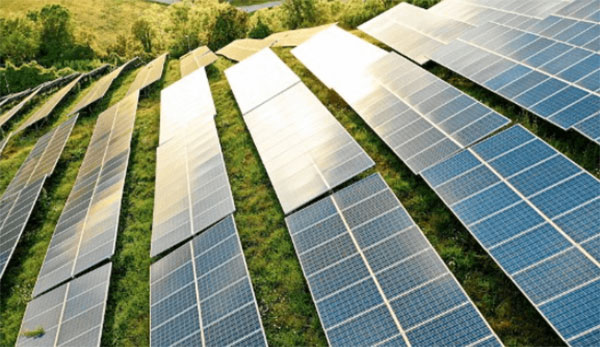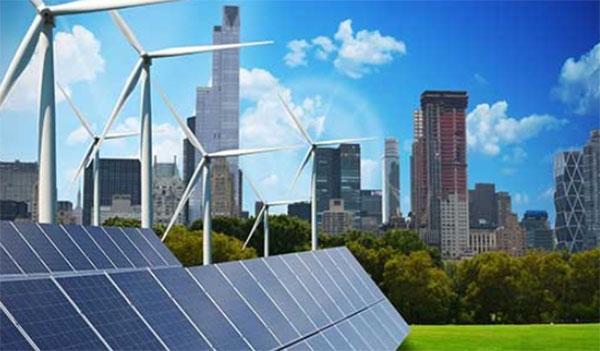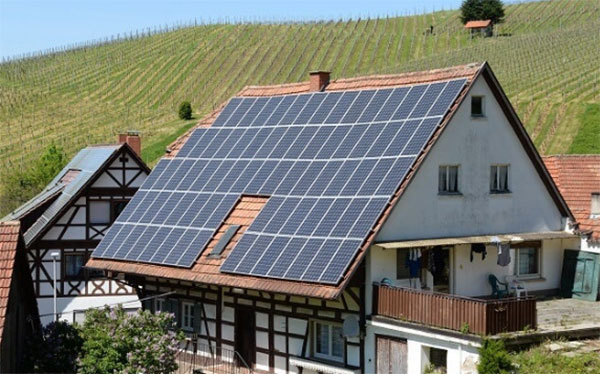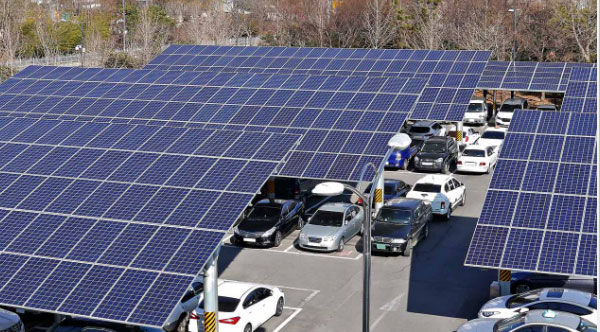
The Science of Solar Panels
Solar panels, a cornerstone of renewable energy, harness the sun's power and convert it into electricity. This process not only propels us towards a sustainable future but also plays a pivotal role in mitigating the adverse effects of climate change by significantly reducing greenhouse gas emissions.
Basics of Solar Energy Conversion
Solar energy conversion is an intricate process where sunlight is directly transformed into electricity. This transformation occurs in solar cells, typically made of silicon. When sunlight hits a solar cell, it energizes the electrons in the silicon, creating an electric current. This process, known as the photovoltaic effect, is crucial for solar energy conversion. The efficiency of this conversion is paramount, as it determines the amount of electricity that can be generated. The average efficiency of solar panels is about 15-20%, but with ongoing technological advancements, some high-end models reach efficiencies beyond 22%.
Photovoltaic Technology and Its Efficiency
Photovoltaic technology has evolved significantly over the years. The efficiency of solar panels, a critical factor in their performance, refers to their ability to convert sunlight into usable electricity. It's influenced by various factors such as the materials used, the architecture of the solar cell, and the quality of manufacturing. For instance, monocrystalline solar panels, made from a single, pure silicon crystal, offer efficiencies up to 22%. In contrast, polycrystalline panels, composed of multiple silicon crystals, have efficiencies between 15% and 17%.
The efficiency of solar panels is not just about the percentage of sunlight converted into electricity; it's also about how long they can maintain high performance. The lifespan of solar panels typically ranges from 25 to 30 years, ensuring a long-term, sustainable energy solution. During their operational life, the performance of solar panels might degrade slightly, usually at a rate of about 0.5% to 1% per year, depending on the quality of the panel and the environment it's in.

Comparison with Traditional Energy Sources
The shift from traditional energy sources like fossil fuels to solar energy represents a significant stride towards sustainability. The comparison primarily hinges on emission rates, lifecycle greenhouse gas emissions, and other factors such as cost, efficiency, and lifespan.
Emission Rates: Solar vs. Fossil Fuels
| Factor |
Solar Energy |
Fossil Fuels |
| Emission Rates |
Virtually zero direct emissions. Solar panels produce electricity without emitting greenhouse gases. |
High. Burning coal, oil, or gas releases significant amounts of CO2 and other greenhouse gases. |
| Efficiency |
Average efficiency ranges from 15-22%. With technological advancements, some models exceed 22%. |
Efficiency varies. Modern gas-fired power plants can achieve efficiencies up to 60%, while coal is around 40%. |
| Lifespan |
Generally 25-30 years, with performance slightly degrading each year (about 0.5% to 1%). |
Varies greatly but often requires more frequent maintenance and upgrades compared to solar installations. |
| Cost Over Time |
High initial cost, but minimal maintenance and operational costs. Long-term savings due to low operating costs. |
Generally lower initial costs but higher operational and maintenance costs, including fuel expenses. |
Lifecycle Greenhouse Gas Analysis
A comprehensive analysis of the greenhouse gas emissions from energy sources must include their entire lifecycle, from extraction and production to disposal.
| Factor |
Solar Energy |
Fossil Fuels |
| Material Extraction |
Low emissions. Mainly related to the extraction and processing of raw materials like silicon. |
High emissions. Extraction of coal, oil, or gas is energy-intensive and releases substantial greenhouse gases. |
| Production |
Moderate emissions. Associated with the manufacturing of solar panels. |
High emissions. Refining and transporting fossil fuels is energy-intensive and emits greenhouse gases. |
| Operation |
Minimal emissions. Solar panels do not emit greenhouse gases during operation. |
Very high emissions. The combustion of fossil fuels for energy is a major source of greenhouse gas emissions. |
| Disposal/Recycling |
Low to moderate emissions. Recycling practices are improving, but some challenges remain in handling solar panel waste. |
Moderate emissions. Includes emissions from decommissioning plants and managing waste, like ash from coal plants. |

Role in Reducing Carbon Footprint
Solar energy's pivotal role in reducing the carbon footprint is undeniable, significantly impacting both residential sectors and utility-scale productions. The adoption of solar panels not only curbs reliance on fossil fuels but also sets a sustainable model for future energy consumption.
Solar Panels in Residential Sectors
The integration of solar panels into residential areas has seen a surge, driven by the desire to reduce energy costs and make a positive environmental impact. The specifics are as follows:
- Cost and Savings: The initial installation cost of solar panels can be high, often ranging between $15,000 and $25,000. However, federal tax credits and local incentives can significantly reduce this cost. Moreover, the average savings on electricity bills can be substantial, with most households saving tens of thousands of dollars over the lifespan of their solar panel system.
- Efficiency and Specifications: Residential solar panels typically have an efficiency rate of 15-20%. The size and number of panels required depend on household energy needs, roof size, and exposure to sunlight.
- Lifespan and Maintenance: Solar panels for residential use generally last 25-30 years with minimal maintenance, usually involving regular cleaning and occasional checks by a professional.
Utility-Scale Solar Farms and Emission Reduction
Utility-scale solar farms significantly contribute to emission reduction by producing large amounts of clean energy. Key aspects include:
- Capacity and Coverage: These installations can cover hundreds of acres and have capacities ranging from 1 MW to over 500 MW, capable of powering tens of thousands of homes.
- Impact on Emissions: Utility-scale solar farms are instrumental in reducing greenhouse gas emissions. For instance, a 100 MW solar farm can reduce carbon emissions by approximately 200,000 tons each year, equivalent to taking nearly 40,000 cars off the road.
- Economic Benefits: Besides environmental benefits, these solar farms generate jobs and can stabilize local economies. They offer a steady income stream for landowners and tax revenues for local governments.

Challenges and Environmental Impact
While solar energy is a clean and sustainable source, it's not without its challenges, particularly in the areas of manufacturing, recycling, and ecological impact. Addressing these challenges is crucial for ensuring the sustainable growth of solar energy.
Manufacturing and Recycling of Solar Panels
The production and end-of-life disposal of solar panels involve complex processes with environmental implications:
- Materials and Manufacturing: The manufacturing of solar panels involves the use of hazardous materials like lead and cadmium. Ensuring proper handling and disposal of these materials is essential to minimize environmental contamination.
- Energy Consumption: The production process is energy-intensive, contributing to indirect emissions. However, the energy payback time (the time it takes for a solar panel to generate the amount of energy that was used to produce it) is generally short, ranging from 1 to 4 years.
- Recycling Challenges: Solar panel recycling is in its nascent stages, and the recycling process can be complex and costly. However, efforts are underway to develop more efficient recycling technologies to recover valuable materials like silver and silicon.
- Advancements in Technology: Manufacturers are increasingly adopting greener manufacturing processes and are working towards making solar panels completely recyclable, reducing the environmental footprint of solar panel production and disposal.
Land Use and Ecological Considerations
The installation of solar farms, especially utility-scale projects, requires significant land, which can lead to land use conflicts and ecological disturbances:
- Habitat Disruption: Large solar installations can disrupt local ecosystems, impacting wildlife habitats and land use patterns.
- Land Use Efficiency: Solar farms typically require 5-10 acres per megawatt, making land use efficiency a critical consideration. The choice of location is vital to minimizing the impact on natural habitats and agricultural land.
- Dual-Use Solutions: Innovations like agrivoltaics (combining solar energy production with agriculture) are emerging to make solar energy more land-efficient and to provide a dual income stream for farmers.
- Mitigation Strategies: Careful planning and environmental impact assessments are necessary to mitigate the ecological impacts of solar installations. Efforts include setting up solar panels on already disturbed lands, such as landfills or industrial zones, and ensuring proper restoration of land post-decommissioning of solar farms.

Policy and Economic Incentives
The adoption of solar power is significantly influenced by governmental policies and the economic benefits it offers. Understanding these drivers is key to recognizing the potential and scalability of solar energy solutions.
Government Policies Promoting Solar Energy
Governments worldwide have recognized the importance of solar energy in achieving energy independence and reducing carbon emissions. As a result, various policies and incentives have been put in place:
- Feed-in Tariffs (FITs): These policies allow electricity generated by solar panel owners to be sold back to the grid at a premium price, encouraging investment in solar technology.
- Tax Credits and Rebates: Many governments offer tax benefits and rebates to offset the initial installation cost of solar panels, making solar energy more accessible and affordable.
- Renewable Portfolio Standards (RPS): These standards require a certain percentage of electricity to be generated from renewable sources, thereby promoting the adoption of solar energy.
- Net Metering: This allows residential and commercial customers who generate their own electricity from solar panels to sell the electricity they aren't using back into the grid.
Economic Benefits of Adopting Solar Power
The economic advantages of solar energy are not only beneficial for individual households but also for the economy as a whole:
- Reduction in Electricity Bills: Solar panels significantly reduce or even eliminate electricity bills. The average solar panel system can save a household thousands of dollars over its lifetime.
- Increase in Property Value: Homes equipped with solar energy systems have higher property values and sell more quickly than non-solar homes. Studies have found that solar panels increase a home’s value by 4.1% on average.
- Job Creation: The solar industry is labor-intensive, meaning that the investment in solar energy creates more jobs per unit of electricity generated than fossil fuels. This includes jobs in manufacturing, installation, maintenance, and research and development.
- Energy Independence: By investing in solar energy, countries can reduce their dependence on imported fuels, creating a more stable and secure energy supply.








